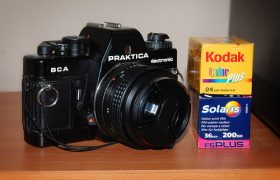To get a great photo, make sure your subject fills the frame. Too much empty space will distract the viewer, and they will not know what they are meant to be focusing on. A tight crop on your subject will direct the eye and show more details that will transform your image into a story.
Purchase a DSLR (Digital Single-Lens Reflex) camera if you want to take professional-looking photographs. When you are shopping for a camera, do not worry about how many megapixels the product has; instead, focus on the image sensor. Most professional photographers buy full-frame DSLR cameras, which take incredibly clear pictures of your subject matter.
Learn to turn your camera on it’s side. If the subject that you are shooting is taller than it is wide, then use your camera to make it take up more of the frame. Turn your camera on it’s side and take a vertical picture instead of the traditional horizontal one.
Make sure your photos tell a story by leading the viewer’s eyes around the frame. Do not simply snap a photo of a scene and expect others to see in it what you did. Try to frame the picture in a way that cuts out clutter and focuses on your subject while still giving a sense of the surroundings for context.
When trying to get that perfect photograph, take lots of shots. The beauty of digital photography is that you can take countless shots of a scene to get the picture that is just right. There is no need to worry about wasting film because you have unlimited space. Take lots of shots to make sure you will get the perfect frame.
Try keeping something interesting in the foreground of your landscape photos to add more appeal to the images. Including something simple, like a rock or a leaf, could add an additional view of the photo. The viewers will now see the frame entirely, and it will really help them to empathize with the main subject.
An important tip to consider when dealing with photography is that you always want to use the rule of thirds when taking landscape pictures. This means that you want to have 2/3 of your shot land and 1/3 sky, or vice versa. This is a guide to help frame your shot correctly.
You may surprise yourself with the quality of some of the pictures you take, and then be equally disappointed by other shots you have taken in the same time frame. Understanding the ideal circumstances to take pictures in can perfect your eye, and make for an excellent shot, almost every time.








